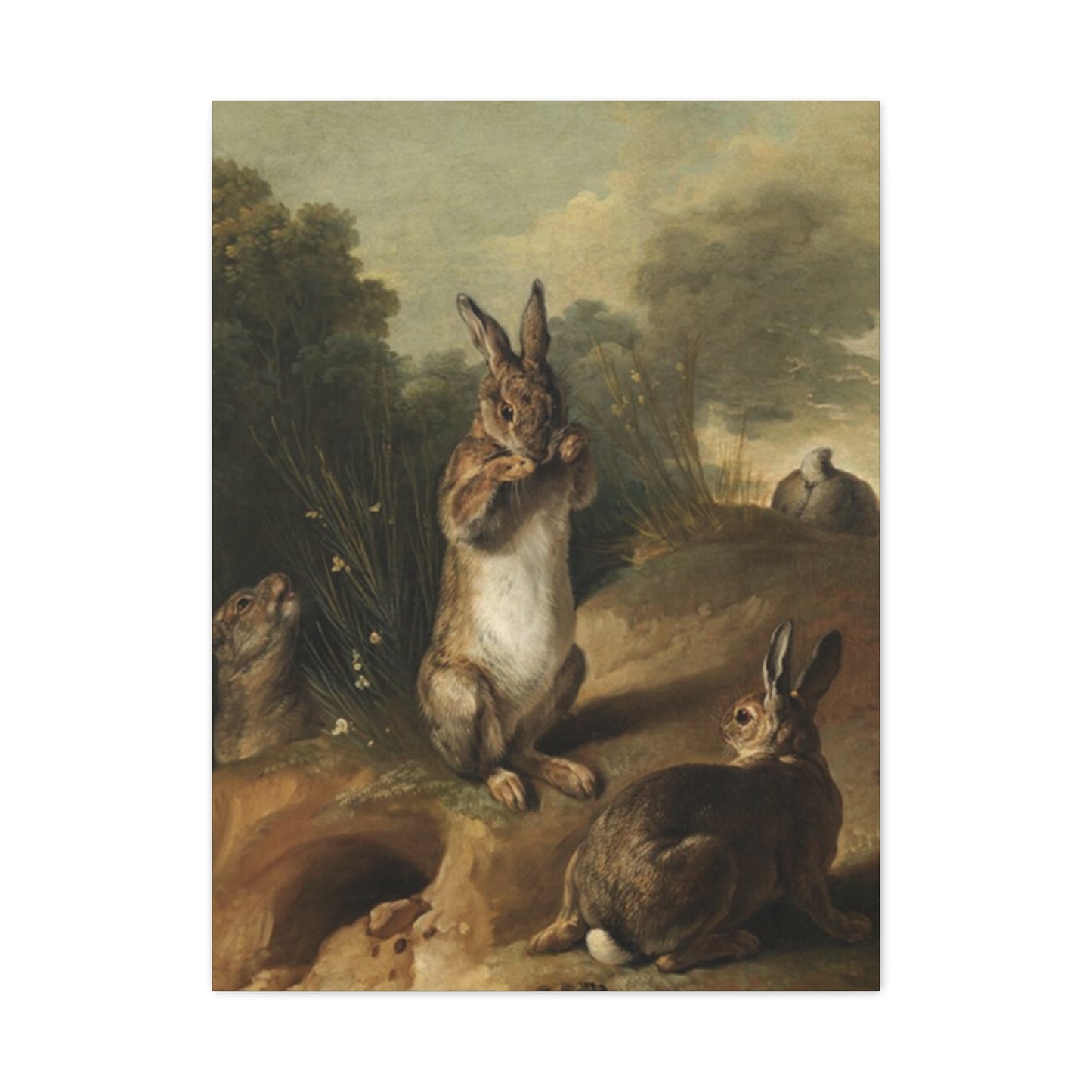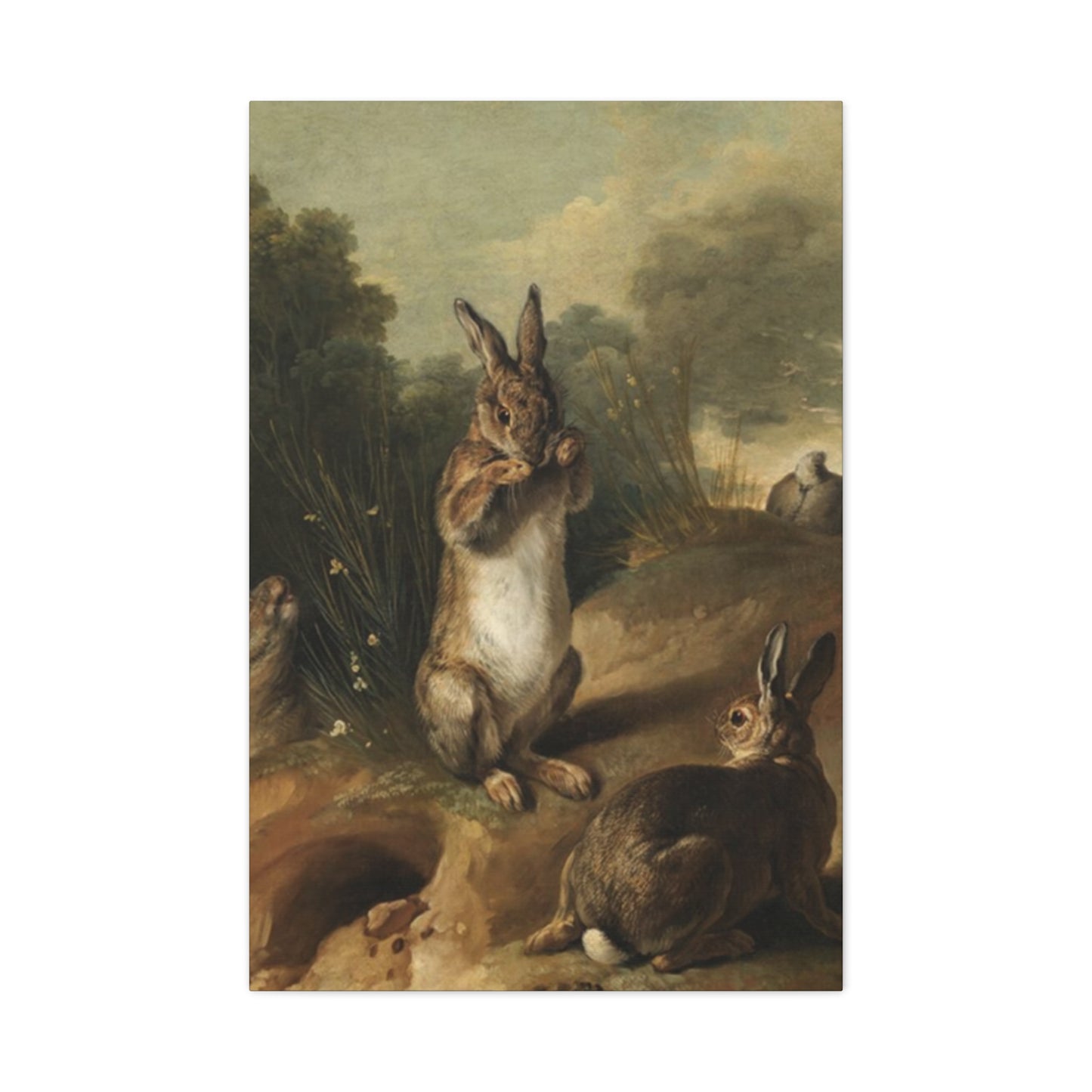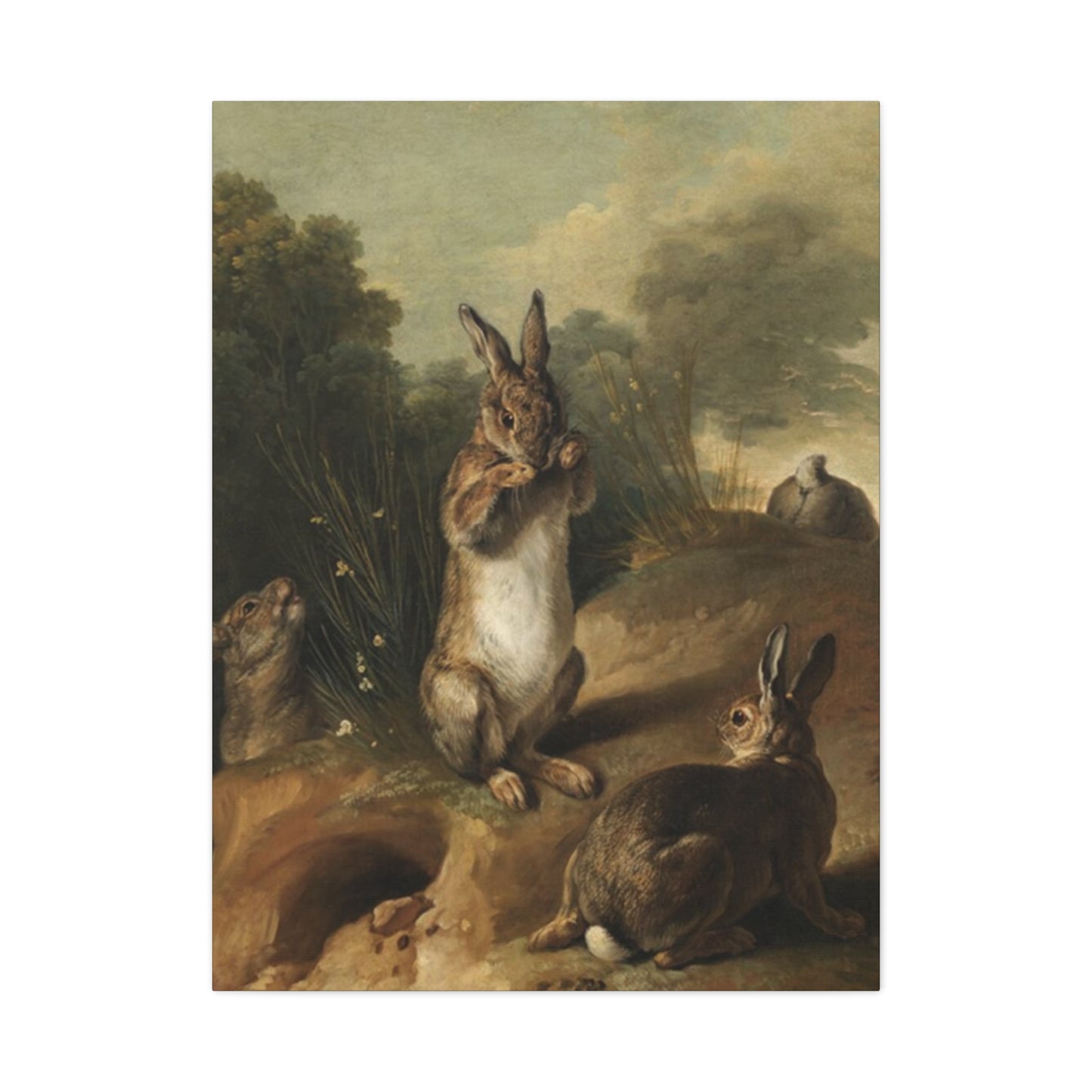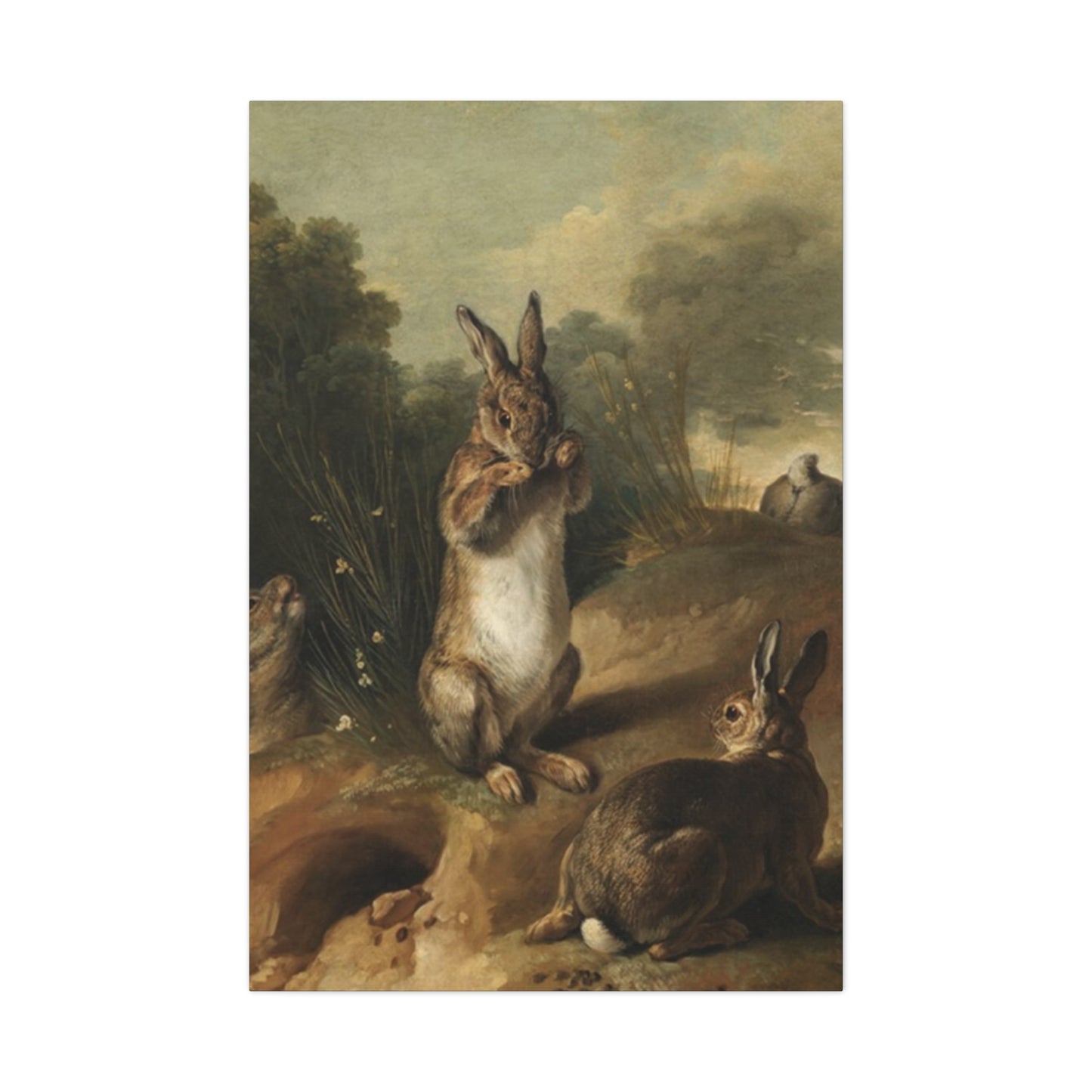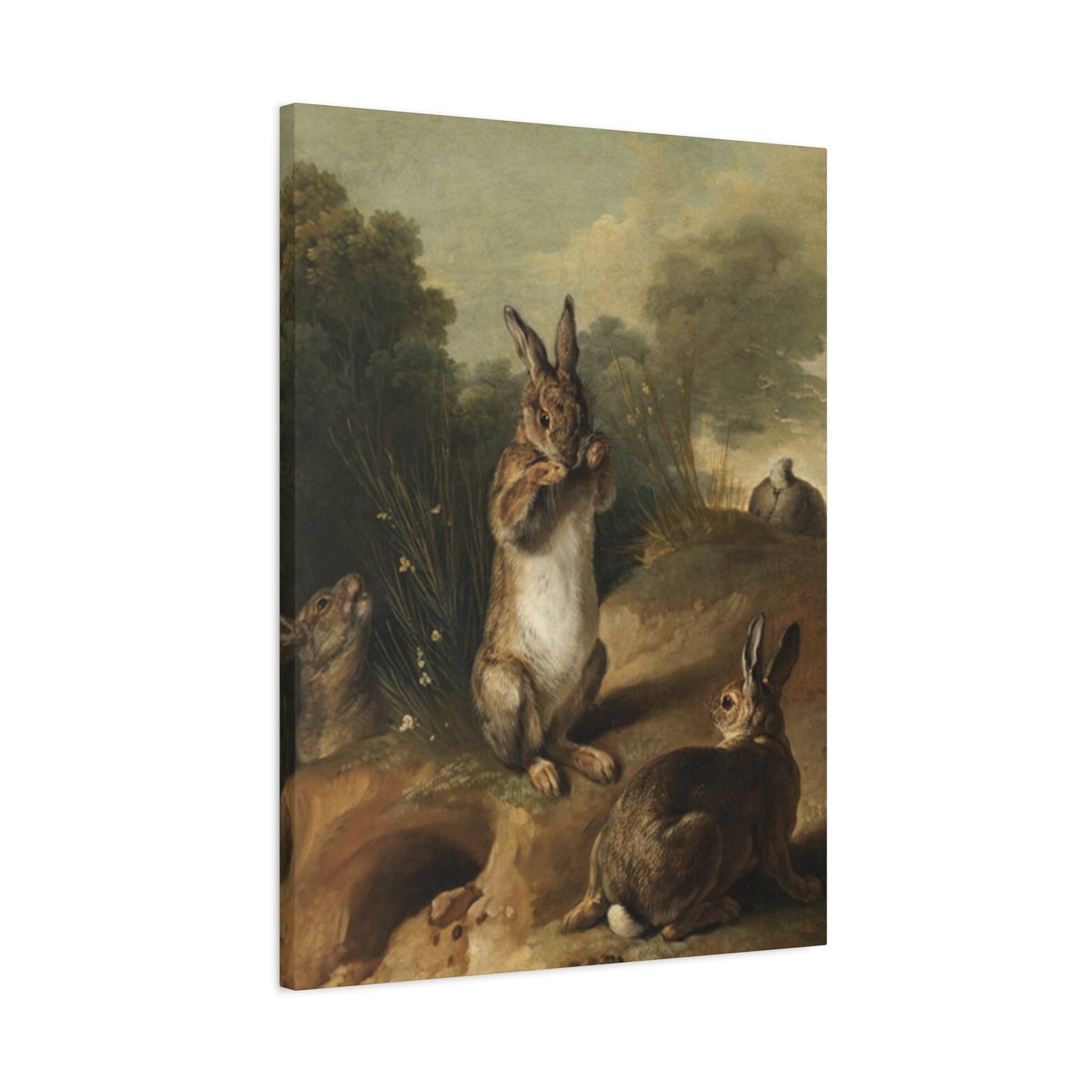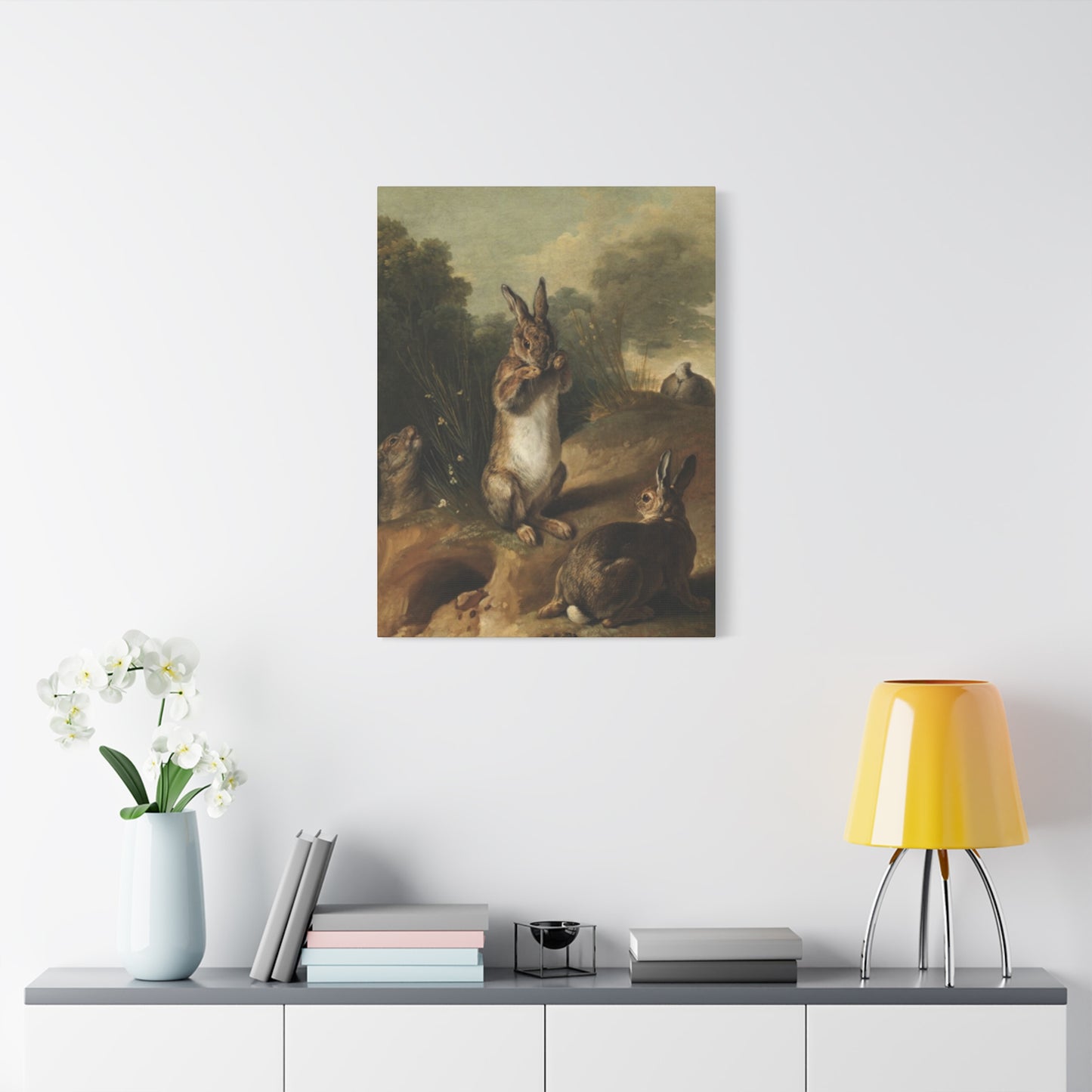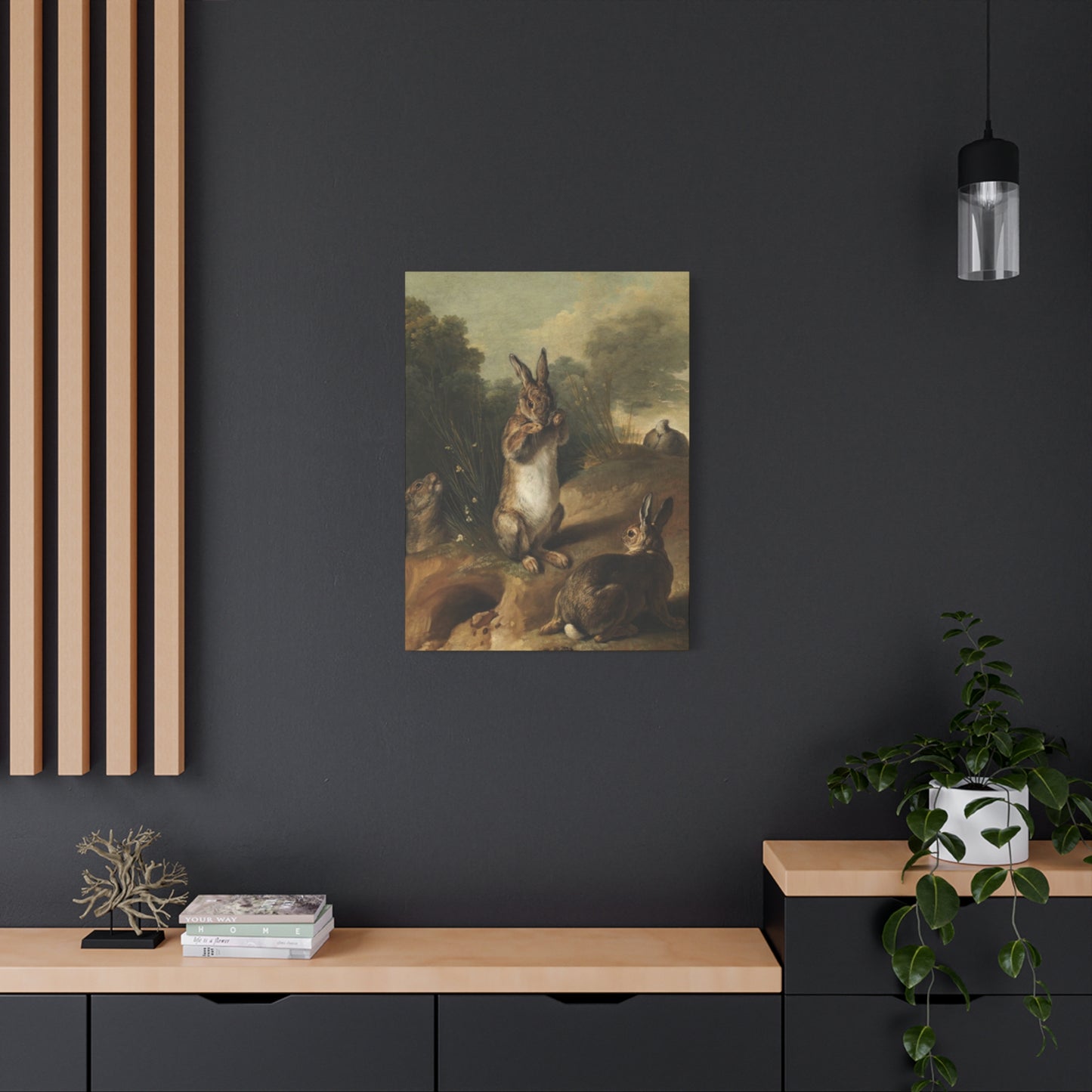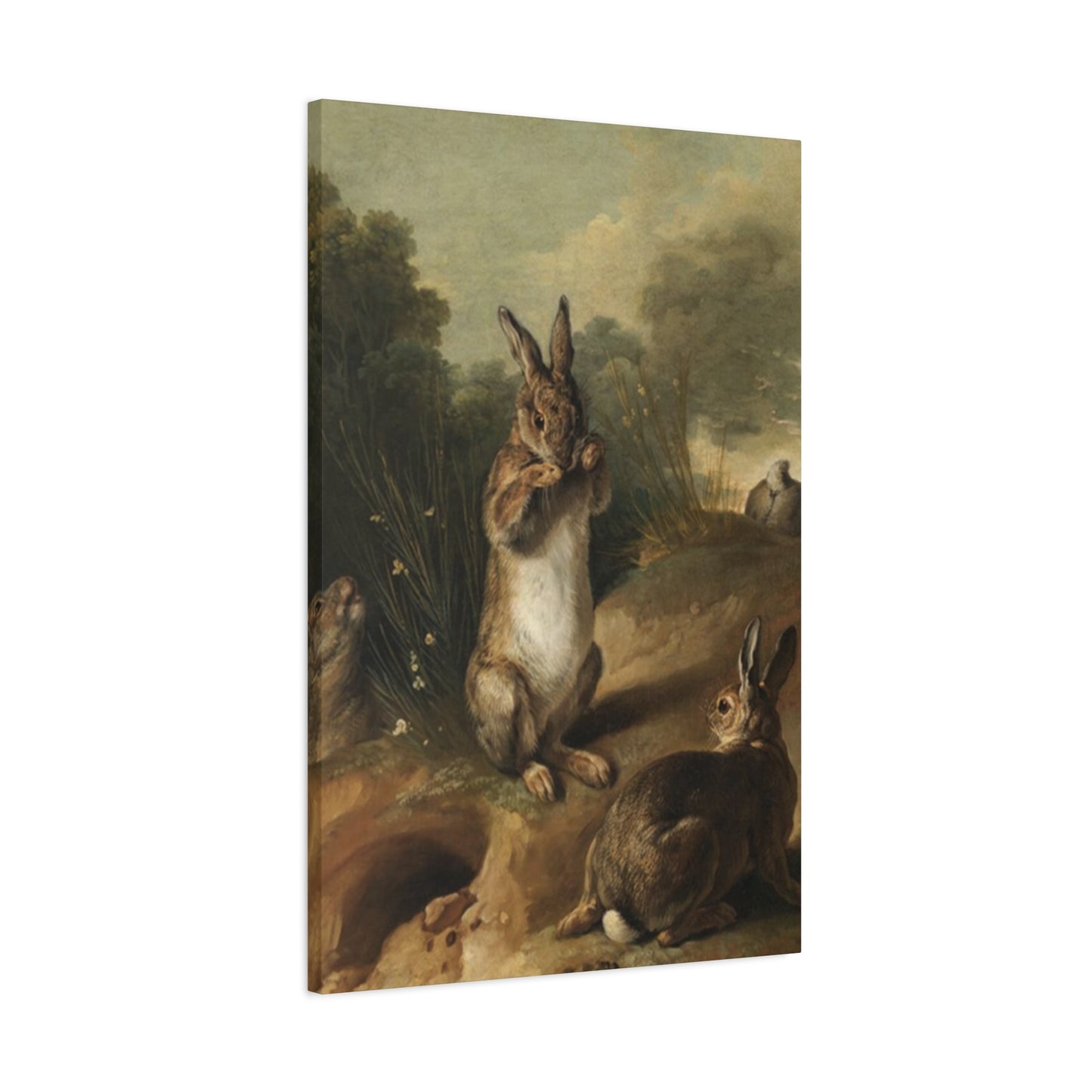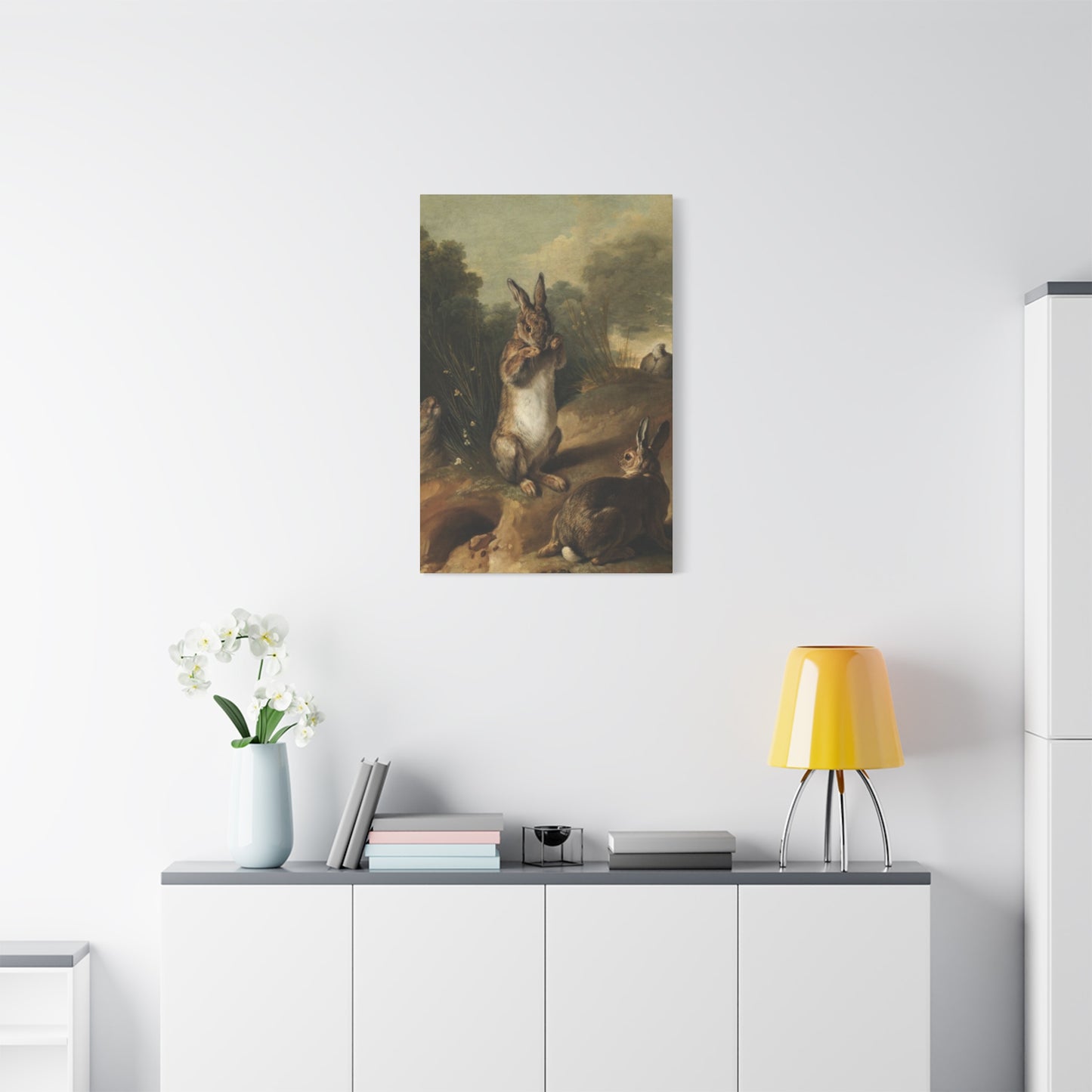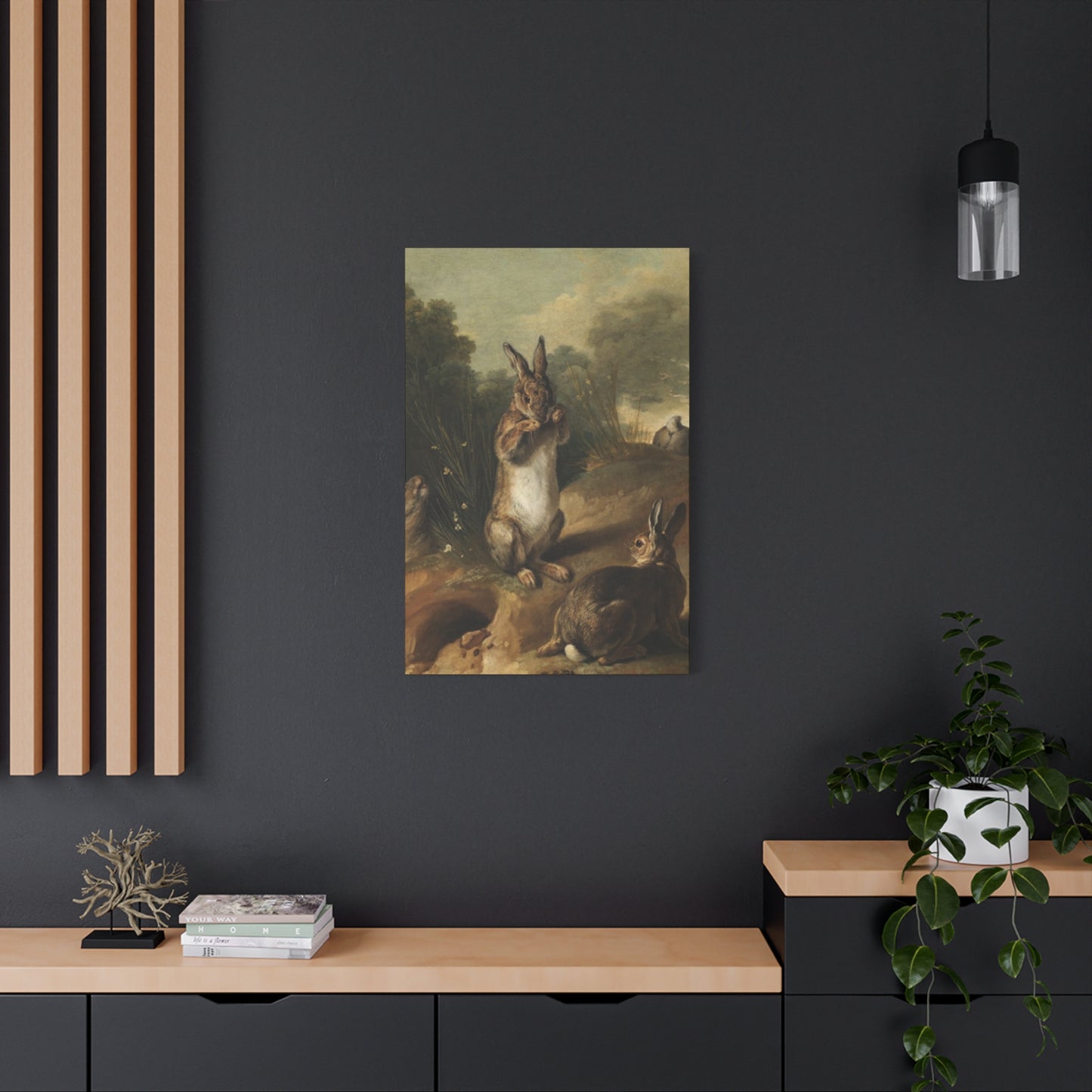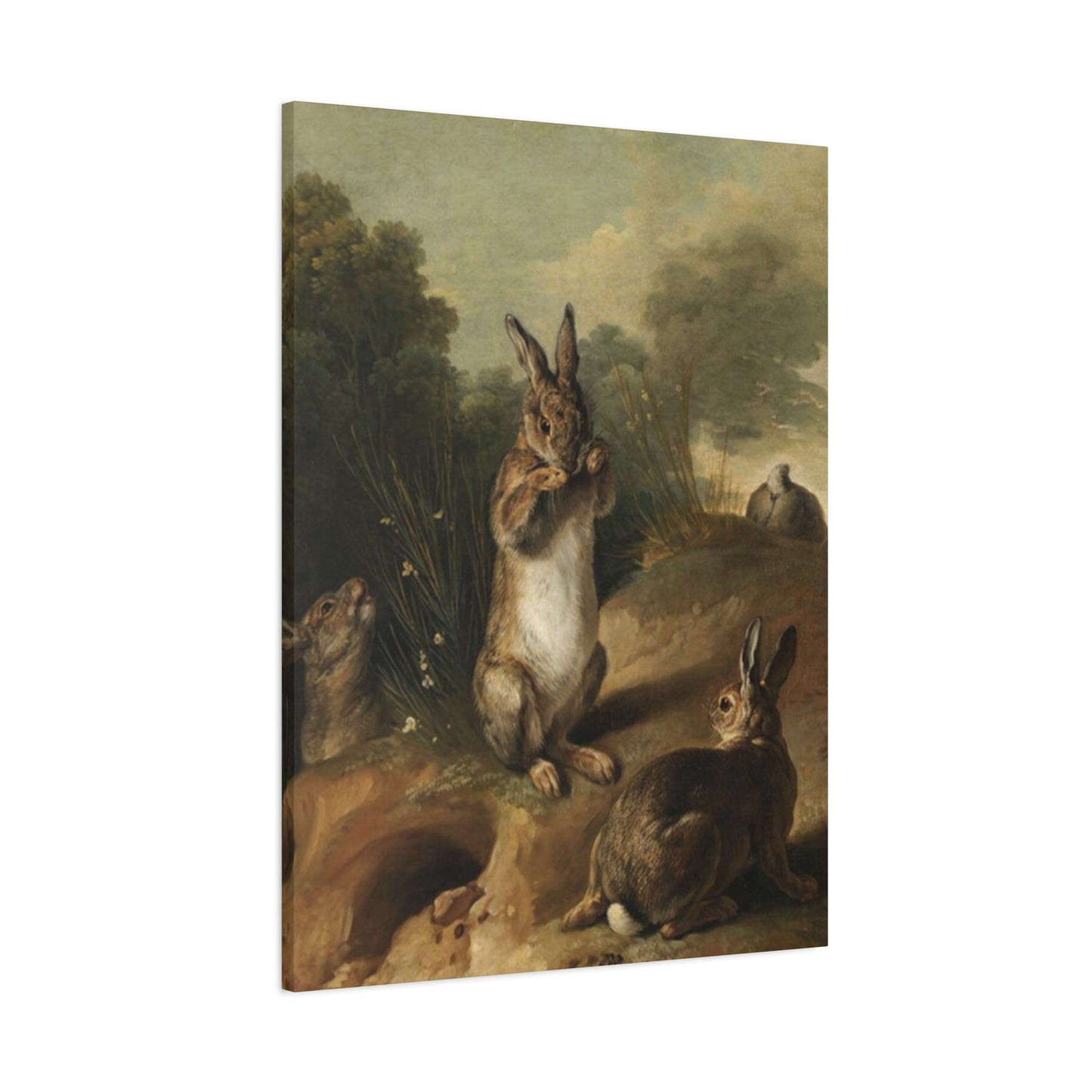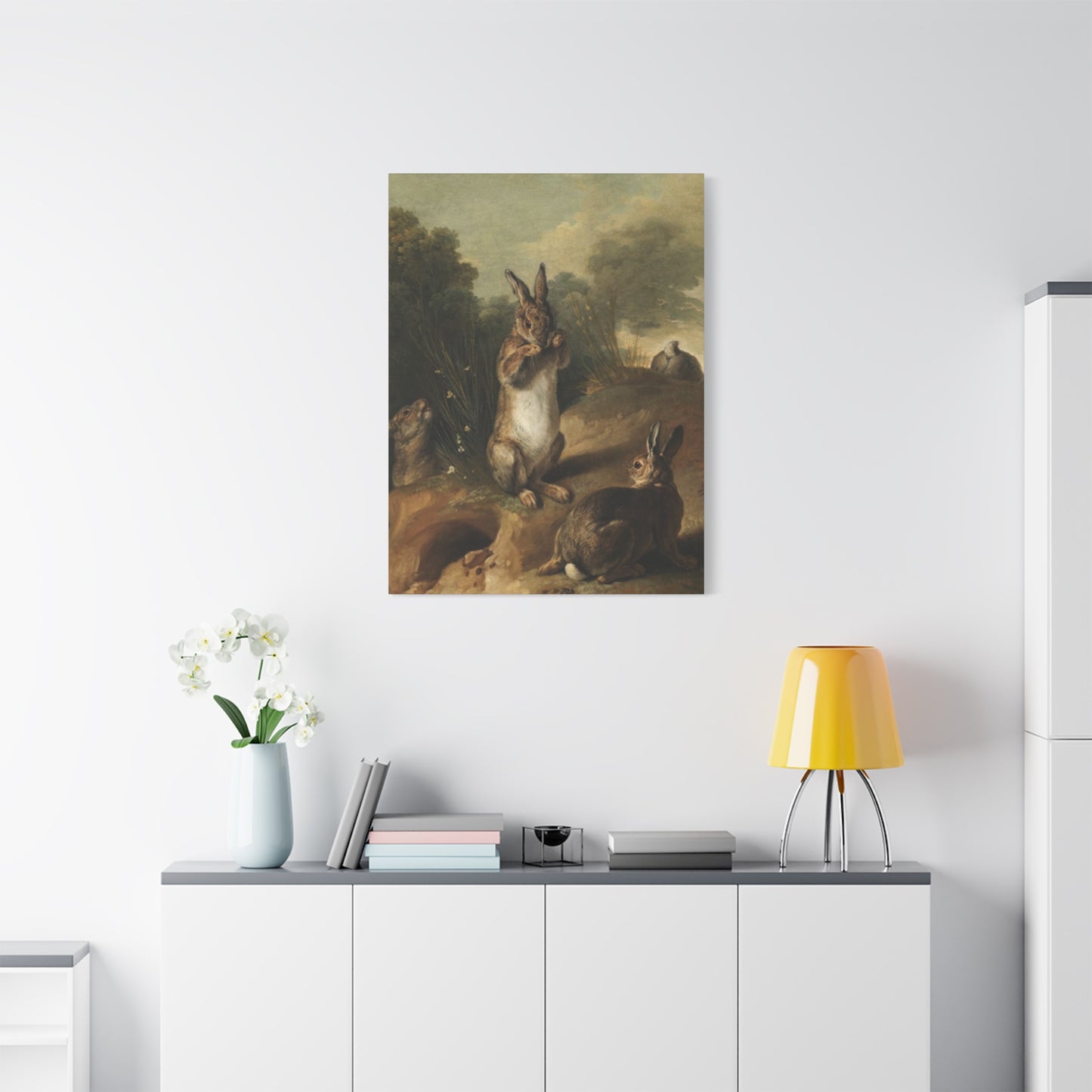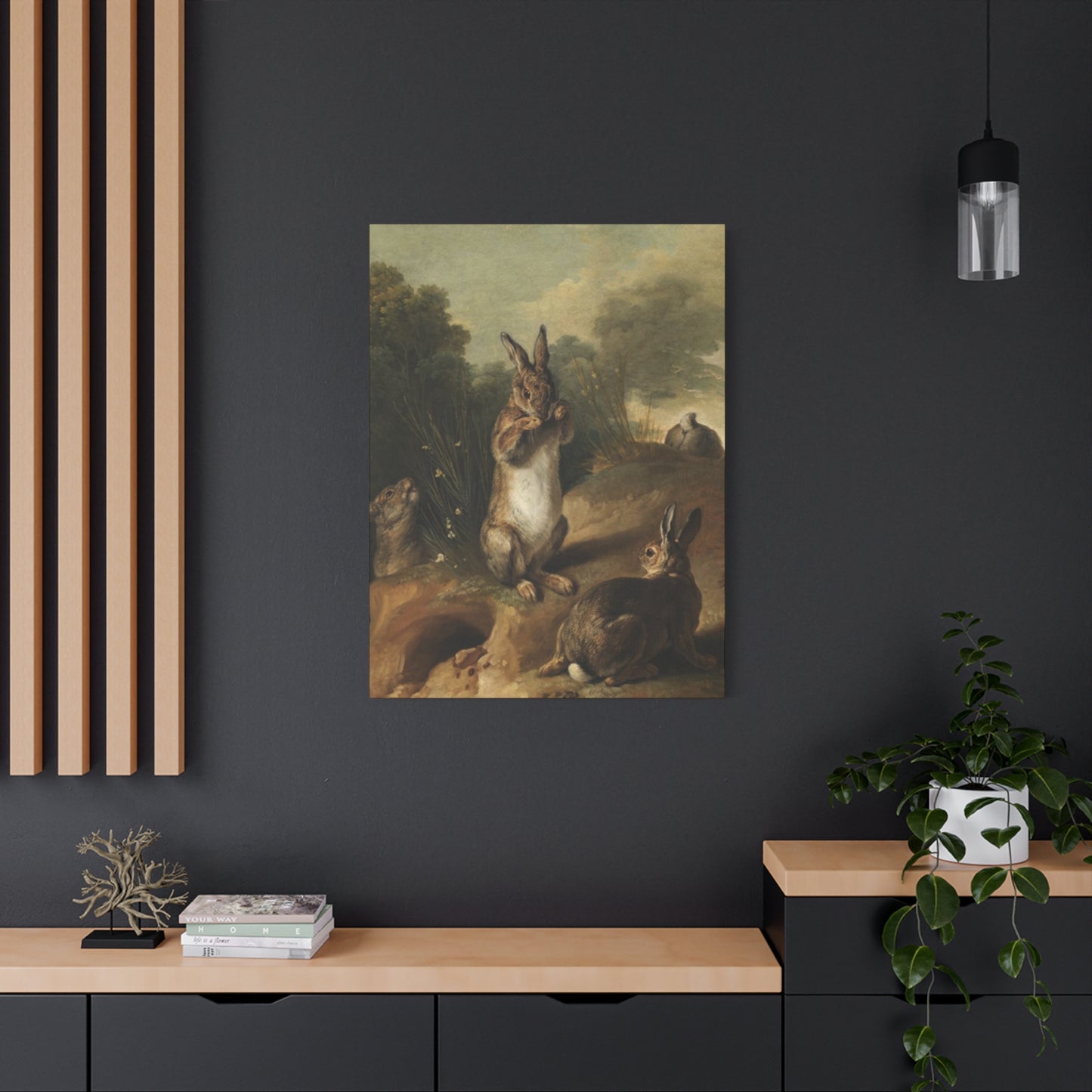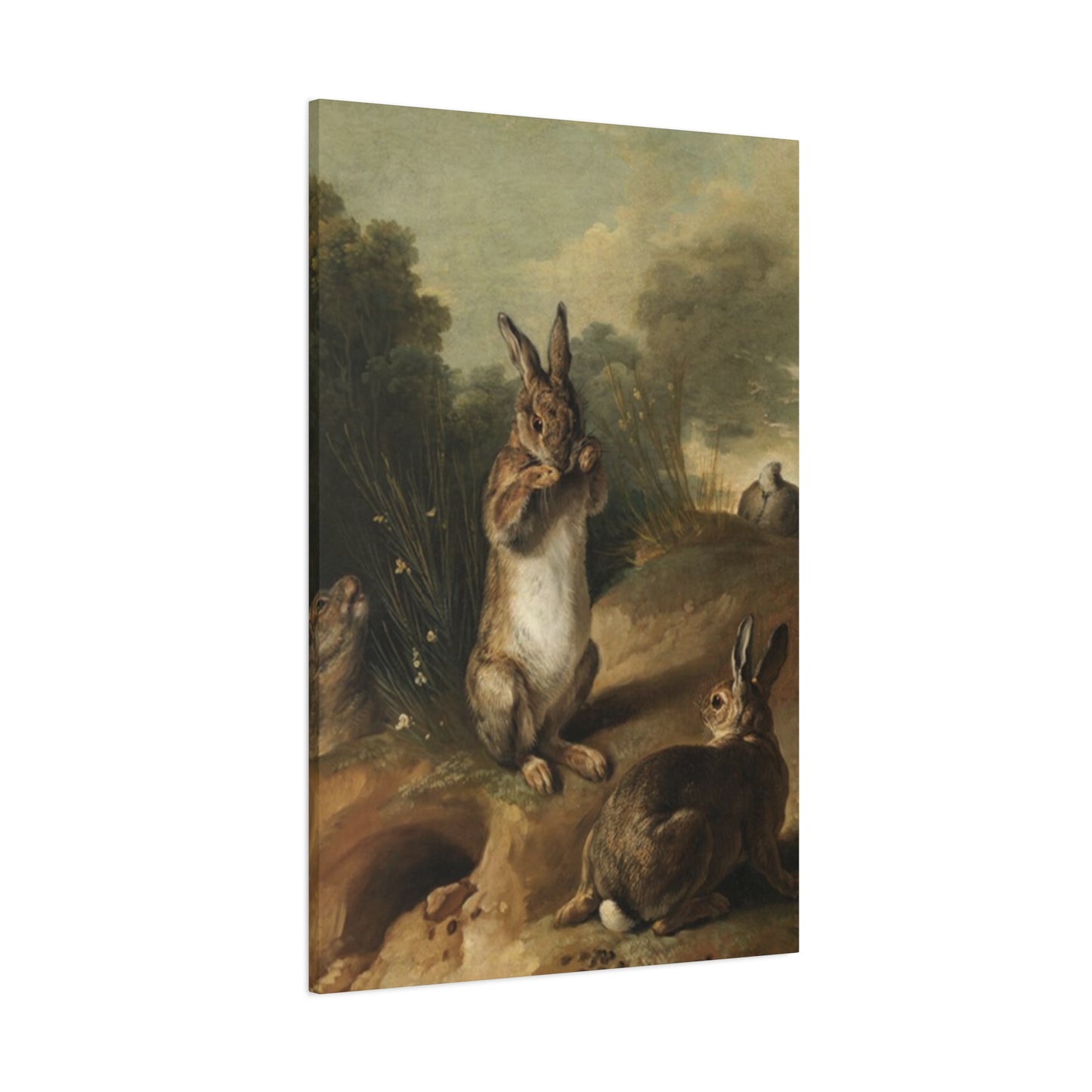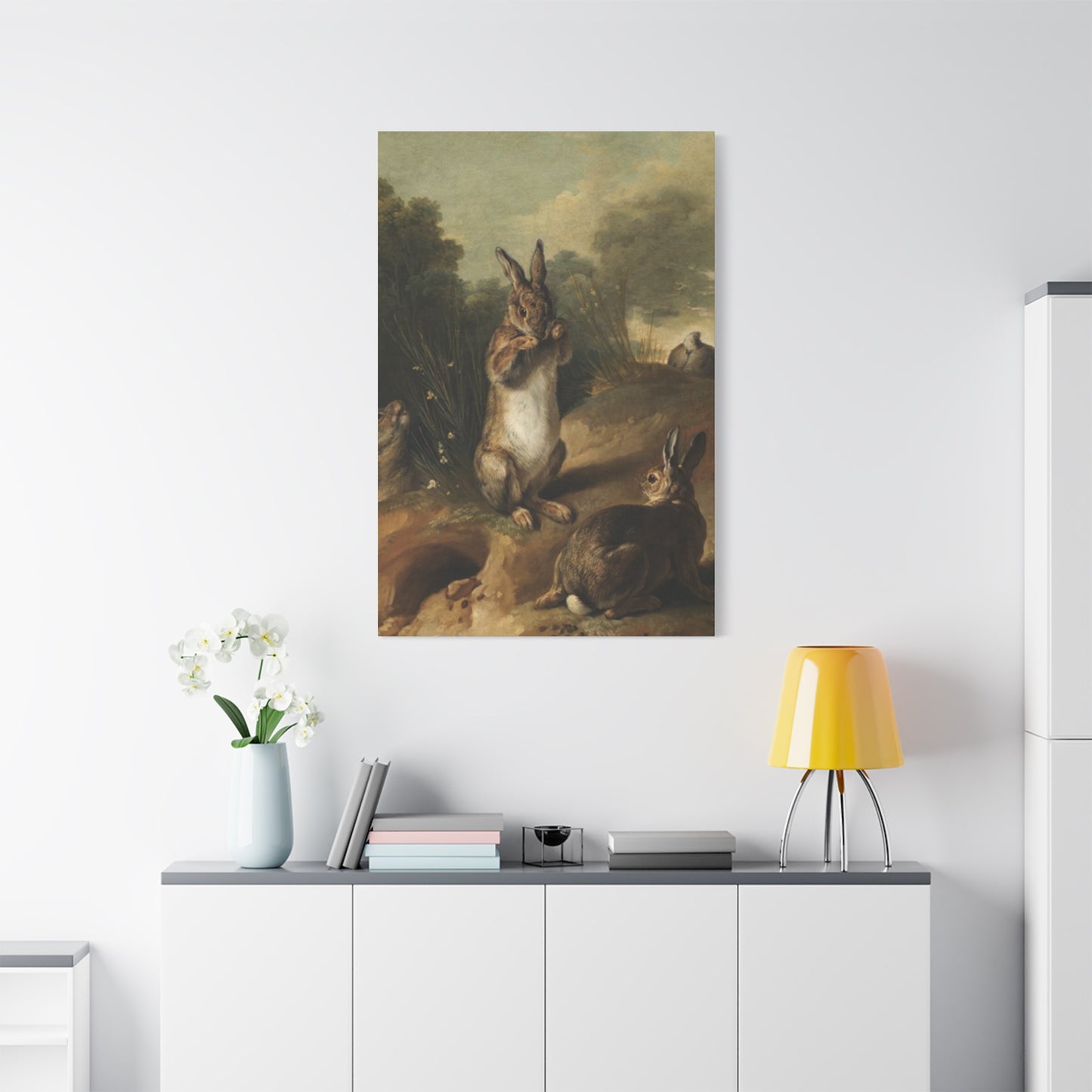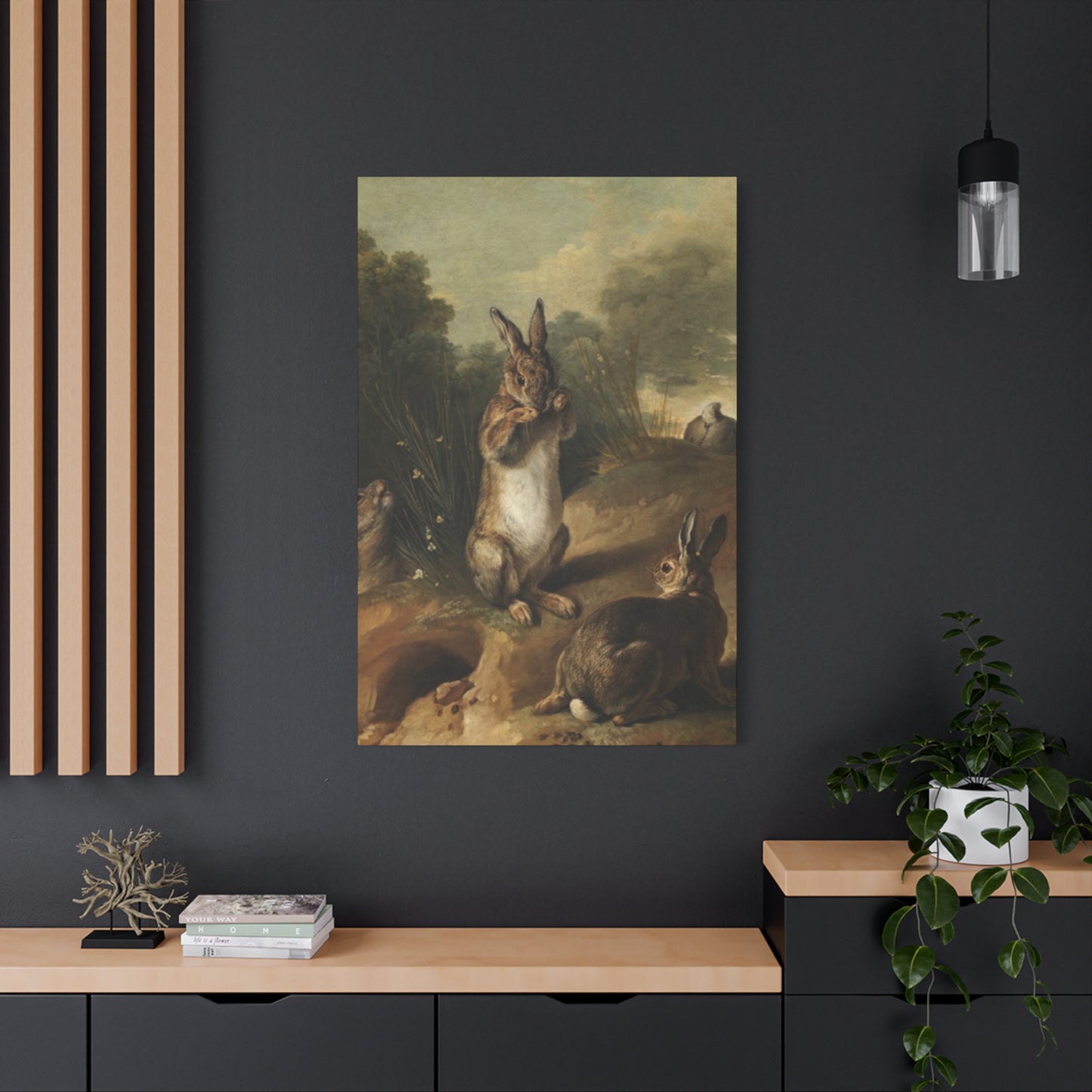Evoking Nature's Whispers: A Deep Dive into Rabbit in the Wild Wall Art for Your Home
The spaces we inhabit are more than just collections of walls and furniture; they are extensions of our personalities, sanctuaries from the outside world, and canvases upon which we paint the stories of our lives. In the pursuit of creating a home that feels both personal and peaceful, the art we choose to display plays a pivotal role. It can set a mood, evoke a memory, or simply provide a moment of beauty in a busy day. Among the vast expanse of artistic subjects, there is a particular, quiet magic to be found in depictions of wildlife. Specifically, the image of a rabbit in its natural, untamed environment offers a unique blend of serenity, charm, and a profound connection to the natural world. This art form, often referred to as "Rabbit in the Wild" wall art, transcends mere decoration. It is an invitation to pause, to breathe, and to bring a piece of the serene, rustic outdoors into the very heart of our homes.
This comprehensive exploration delves into the multifaceted world of wild rabbit art, examining how these captivating images can be woven into the fabric of any interior design scheme. From creating cozy, comforting nooks to making bold, contemporary statements, the humble rabbit proves to be an incredibly versatile and compelling artistic muse. We will journey through various decor styles, from the raw, earthy appeal of rustic design to the clean, uncluttered elegance of minimalism, discovering how rabbit-themed artwork can be adapted to suit each one. We will uncover the psychological benefits of integrating nature-inspired decor into our living spaces, a concept known as biophilic design, and see how the gentle presence of a rabbit on canvas can soothe the mind and comfort the soul. Furthermore, we will address practical considerations, offering insights into styling different rooms, layering textures for a richer sensory experience, and even finding beautiful, affordable options that make this enchanting art accessible to everyone.
Bring Nature Indoors with Wild Rabbit Paintings
The modern world, with its bustling cities and digital landscapes, often creates a subtle but persistent disconnect from the natural environment. This separation can leave us feeling stressed, ungrounded, and yearning for a touch of organic beauty. The practice of interior design has responded to this deep-seated human need through the concept of biophilic design, which seeks to forge a stronger connection between people and nature within the built environment. One of the most direct and evocative ways to embrace this philosophy is by incorporating art that depicts the natural world. Wild rabbit paintings, in particular, serve as exquisite conduits, channeling the serene and untamed spirit of the outdoors directly onto our walls. These artworks are not merely decorative elements; they are windows into a quieter, more peaceful world, offering a daily dose of nature's tranquility. The psychological benefits of having such imagery in our homes are well-documented. Gazing upon a scene of a rabbit nestled in a sun-dappled meadow or perched alertly at the edge of a forest can lower cortisol levels, reduce anxiety, and promote a sense of calm and well-being.
The artistic styles available for wild rabbit paintings are as diverse as the environments these creatures inhabit. For those who appreciate meticulous detail and a lifelike portrayal, realism offers breathtaking accuracy, capturing the delicate texture of fur, the intelligent gleam in an eye, and the intricate details of the surrounding flora. These paintings feel almost photographic, pulling the viewer directly into the scene. Conversely, impressionistic interpretations use color, light, and brushstrokes to convey the feeling or a fleeting moment of a rabbit in the wild. These pieces are less about precise representation and more about capturing the essence of movement, the softness of the light, and the overall atmosphere of the scene. Abstract wild rabbit art takes this a step further, deconstructing the form of the rabbit into shapes, colors, and lines that evoke the animal's energy and spirit without literal depiction. This style is perfect for modern interiors where art is meant to provoke thought and emotion.
The color palette of these paintings plays a crucial role in setting the mood of a room. Artworks dominated by the soft greens of spring foliage, the earthy browns of the forest floor, and the warm ochres of a late summer field instill a sense of grounding and stability. They resonate with our primal connection to the earth and create a nurturing, stable atmosphere. Paintings that feature the cool blues of a misty morning or the soft lavender tones of twilight can transform a space into a serene sanctuary, ideal for bedrooms or reading nooks where relaxation is paramount. The symbolism of the rabbit itself adds another layer of meaning to the decor. Across many cultures, rabbits are symbols of luck, abundance, fertility, and agility. Bringing this imagery into the home can be seen as an invitation for these positive qualities to manifest in one's life. When choosing the right wild rabbit painting, consider the function of the room. A large, dynamic piece showing a rabbit in motion might be perfect for a living room, inspiring energy and conversation. In a study or home office, a more contemplative piece, perhaps of a rabbit in a quiet, still moment, could foster focus and calm.
Cozy Spaces with Rabbit Wall Art
Creating a cozy space is an art form centered on cultivating an atmosphere of warmth, comfort, and security. It is the physical manifestation of feelings of contentment and well-being, often associated with concepts like the Danish "hygge," which celebrates simple pleasures and a feeling of snugness. In this pursuit of coziness, every decorative element contributes to the overall ambiance, and wall art is a particularly powerful tool. Rabbit wall art, with its inherent themes of gentleness, nature, and innocence, is uniquely suited to enhancing the cozy factor in any room. The image of a soft, furry creature nestled in a natural setting immediately evokes feelings of safety and tranquility. It is a visual whisper that encourages us to slow down, curl up with a warm drink, and enjoy the simple comfort of being at home. This type of art transforms a room from a mere physical space into an emotional sanctuary.
The key to leveraging rabbit art for maximum coziness lies in its integration with other sensory elements. The visual softness of a rabbit painting can be amplified by pairing it with an abundance of soft textiles. Imagine a beautiful canvas print of a sleeping rabbit hanging above a sofa adorned with chunky knit throws, plush velvet cushions, and a faux-fur rug underfoot. This layering of textures creates a rich, tactile environment that is irresistibly inviting. The art becomes part of a larger tapestry of comfort, where visual and physical sensations work in harmony. The decor styles that most readily embrace this aesthetic, such as cottagecore, cabin-chic, and rustic farmhouse, provide a natural home for rabbit wall art. In a cottagecore setting, a painting of a rabbit amongst wildflowers would complement floral fabrics and vintage furniture perfectly. In a cabin-chic or rustic space, a depiction of a snowshoe hare against a wintery, wooded backdrop would feel right at home alongside a stone fireplace, warm woods, and plaid textiles.
Lighting is another critical component in the creation of a cozy atmosphere. Harsh, overhead lighting can feel clinical and unwelcoming. To enhance the warmth suggested by your rabbit wall art, opt for layered, ambient lighting. A combination of table lamps with soft, fabric shades, floor lamps that cast a warm glow, and perhaps even the gentle flicker of candlelight can work wonders. This type of lighting softens the edges of a room and highlights the artwork in a gentle, intimate way, making the scene in the painting feel even more serene and personal. Creating dedicated cozy nooks is an excellent strategy for concentrating this feeling of comfort. A reading corner with a comfortable armchair, a soft ottoman, and a small side table becomes the perfect vignette when anchored by a charming piece of rabbit wall art. It becomes a designated spot for unwinding and escape, with the artwork serving as a peaceful focal point. The color schemes that best support this cozy endeavor are those drawn from nature itself. A palette of warm earth tones, muted greens, creamy whites, and soft greys creates a soothing backdrop that allows the artwork and the comfortable furnishings to shine.
Wildlife-Inspired Rabbit Canvas Decor
When choosing artwork for your home, the medium on which the image is presented is just as important as the image itself. While traditional paper prints behind glass have their place, canvas decor offers a distinct set of qualities that make it exceptionally well-suited for wildlife-inspired art, especially depictions of rabbits. Canvas brings a unique textural quality and depth to an image that paper often cannot replicate. The subtle woven texture of the canvas surface can interact with the printed image, adding a tangible, painterly feel that enhances the organic nature of the subject. This is particularly effective for rabbit art, where the canvas texture can subtly mimic the softness of fur or the rustic quality of a woodland setting, creating a more immersive and satisfying viewing experience. This inherent texture helps the artwork feel less like a flat reproduction and more like an original piece, lending an air of authenticity and artistic integrity to your space.
One of the most appealing aspects of rabbit canvas decor is the versatility of its presentation. The most popular modern format is the gallery-wrapped canvas. In this style, the canvas is stretched around a wooden frame, known as a stretcher bar, and secured on the back. The image extends around the sides of the frame, creating a clean, three-dimensional, and frameless look. This contemporary presentation is perfect for a variety of interior styles, from minimalist to rustic, as it allows the artwork to speak for itself without the distraction of a frame. The absence of glass also means there is no glare, allowing the image to be viewed clearly from any angle and in any lighting condition. For those who prefer a more traditional or defined look, framed canvas options are also widely available. A floating frame, for example, leaves a small gap between the canvas edge and the inside of the frame, creating a sophisticated illusion that the artwork is levitating within its border. This can add a polished, high-end finish to the piece.
Integrating rabbit canvas decor into a broader wildlife-themed interior is a natural fit. A large, striking canvas of a wild rabbit can serve as the focal point, with smaller canvases or framed prints of other woodland creatures like deer, foxes, owls, or birds arranged around it to create a cohesive gallery wall. The durability of canvas makes it a practical choice for various rooms in the house, including high-traffic areas like living rooms or even bathrooms with controlled humidity, where a paper print might be susceptible to damage. When selecting a piece, it is important to consider the quality of the materials. Look for canvases made from high-grade cotton or polyester blends and prints that use archival-quality, fade-resistant inks. This ensures that the vibrant colors and sharp details of your rabbit in the wild scene will remain beautiful for years to come.
Rustic Charm: Rabbit in Wild Paintings
Rustic interior design is a style that celebrates the unrefined beauty of nature. It is characterized by its use of natural materials, weathered finishes, and a sense of rugged, simple elegance. This design ethos prioritizes comfort, warmth, and a strong connection to the outdoors, making it the perfect backdrop for artwork that echoes these same values. "Rabbit in the wild" paintings are a quintessential element of rustic charm, as they encapsulate the very essence of the style: the quiet beauty of nature, the appeal of simplicity, and a touch of untamed spirit. These paintings do more than just decorate a wall; they reinforce the narrative of a home that is grounded, authentic, and in harmony with its surroundings. The imagery of a rabbit foraging in a forest, peeking from behind a weathered fence post, or resting in a grassy meadow aligns perfectly with the core principles of rustic decor.
The framing of these paintings is a critical detail in achieving an authentic rustic look. The frame should complement the artwork and the overall design scheme, rather than overpowering it. Reclaimed wood frames are an excellent choice, as their knots, grain patterns, and imperfections tell a story and add a layer of history and texture. A distressed finish on a wooden frame, whether painted and sanded down or naturally weathered, can also enhance the rustic feel. For a slightly more modern take on rustic, a simple, thin black or dark bronze metal frame can provide a clean border that allows the natural scene within the painting to take center stage. The key is to choose materials that feel organic and substantial. A gallery wall is a fantastic way to display a collection of rabbit in wild paintings in a rustic setting. You can mix different sizes, orientations, and frame styles to create a dynamic and personal display. Interspersing the paintings with other rustic elements, such as antique mirrors, small wreaths of dried foliage, or vintage botanical charts, can add further depth and interest to the arrangement.
To fully integrate these paintings into a rustic interior, it is important to consider the surrounding environment. This art form shines when paired with the signature elements of rustic design. Imagine a captivating painting of a rabbit in a snowy woodland scene hung above a grand stone fireplace with a chunky wooden mantel. The natural textures of the stone and wood create a harmonious backdrop that amplifies the painting's organic theme. Similarly, placing such artwork on a wall with exposed wooden beams, shiplap, or even a subtle limewash finish helps to create a cohesive and immersive rustic experience. The furniture and accessories in the room should also support this aesthetic. A comfortable linen sofa, a sturdy oak coffee table, and accessories made from natural materials like jute, wool, and burlap will all contribute to the overall sense of rustic charm. The scenery depicted within the paintings is also a vital component. Look for art that features realistic, natural settings: dense forests with filtered sunlight, open fields at dusk, or rocky hillsides.
Entryway Style with Rabbit Wall Art
The entryway, or foyer, is the first chapter in the story of your home. It is the transitional space that welcomes guests and sets the tone for the entire interior. Because it offers the first impression, its design deserves careful consideration. Utilizing rabbit wall art in your entryway is a wonderfully effective way to establish a specific mood right from the threshold. It can immediately communicate a sense of warmth, a connection to nature, and a welcoming, gentle spirit. A thoughtfully chosen piece of art featuring a rabbit in its natural habitat can transform a purely functional space into a charming and memorable introduction to your personal style. It acts as a promise of the comfort and personality that lies within the rest of the home. Instead of a generic or impersonal entrance, you create a space that feels intentional and inviting, suggesting a household that values tranquility and the simple beauty of the natural world.
The scale and placement of the artwork are paramount in an entryway. The size of the art should be proportional to the size of the wall and the space itself. In a small foyer, a single, medium-sized piece might be all that is needed to make an impact without overwhelming the area. In a larger, more grand entryway with high ceilings, you have the opportunity to be more dramatic. A large-scale canvas depicting a sweeping landscape with a rabbit as a subtle but intriguing focal point can be breathtaking. Alternatively, a curated gallery wall of smaller rabbit-themed pieces can add a lot of personality and visual interest. The artwork should be hung at eye level, which is typically around 57 to 60 inches from the floor to the center of the piece, to ensure it is immediately engaging to anyone who enters.
To create a truly stylish entryway, the rabbit wall art should be part of a well-composed vignette. This means pairing it with other functional and decorative elements to create a cohesive and attractive display. A common and effective arrangement involves hanging the artwork above a console table. The table provides a surface for practical items like a bowl for keys or mail, as well as decorative objects that complement the art. For example, you could place a rustic ceramic lamp on the console table to provide warm, welcoming light, a small vase of fresh or dried wildflowers to echo the natural theme of the painting, and perhaps a stack of books. The symbolism of the rabbit can also play a role in the welcoming nature of the space; as creatures often associated with home and hearth, they can subtly reinforce the feeling of "welcome home." Proper lighting is essential to make your entryway art shine. If natural light is limited, consider installing a dedicated picture light above the artwork or ensuring the overhead fixture or nearby lamp casts a warm, direct glow upon it.
Minimalist Rabbit in Wild Artwork
Minimalism, as a design philosophy, is built on the principle of "less is more." It champions simplicity, intentionality, and the removal of clutter to create spaces that are serene, functional, and visually restful. At first glance, the idea of wildlife art might seem at odds with this clean, pared-back aesthetic. However, minimalist rabbit in wild artwork can integrate seamlessly into these spaces, offering a point of organic interest and quiet beauty without disrupting the overall sense of calm. The key is to select artwork that adheres to minimalist principles in its style, composition, and presentation. Rather than a richly detailed, multi-colored oil painting, a minimalist approach favors simplicity of form and a restrained color palette.
The most effective minimalist rabbit artwork often focuses on line and shape. Think of a single, continuous line drawing that captures the elegant silhouette of a hare in motion, or a simple sketch using charcoal or graphite that suggests the form of a rabbit with just a few masterful strokes. These pieces celebrate the power of suggestion and the beauty of negative space. The empty space around the subject is just as important as the subject itself, allowing the artwork and the viewer's mind to breathe. This focus on negative space is a core tenet of minimalist design, preventing the wall from feeling crowded and maintaining the open, airy quality of the room. Monochromatic pieces are particularly well-suited to minimalist interiors. A black and white photograph of a rabbit in a snowy landscape, or a simple ink wash painting using varying shades of grey, can add a touch of sophistication and emotional depth without introducing distracting colors.
The framing and presentation of the artwork are crucial for maintaining a minimalist aesthetic. The frame should be simple and unobtrusive. Thin metal frames in black, white, or a muted metallic finish are excellent choices. A light, natural wood frame, like maple or birch, can also work well, adding a touch of organic warmth that complements the natural subject matter without adding visual clutter. In many cases, a simple gallery-wrapped canvas with clean, white edges might be the best option, requiring no frame at all. When hanging the art, the minimalist ethos dictates a focus on a single, impactful piece rather than a busy gallery wall. One thoughtfully chosen and perfectly placed piece of rabbit art can serve as the sole focal point in a room, drawing the eye and inviting quiet contemplation. The color palette of the artwork should also harmonize with the rest ofthe space. In a typically minimalist room dominated by neutrals like white, grey, and beige, a piece of art that follows a similar muted color scheme will integrate beautifully.
Rabbits on Canvas: Nature’s Beauty
Displaying art on canvas brings a unique and tactile dimension to the visual experience, and this is especially true for subjects drawn from the natural world. When the subject is a rabbit, an animal defined by its softness and its deep connection to the earth, the canvas medium enhances these qualities, creating a piece of art that is not just seen but felt. The beauty of nature, as captured in scenes of rabbits on canvas, is a multifaceted affair, involving the artist's skill in portraying detail, movement, atmosphere, and the subtle nuances of the changing seasons. The canvas itself, with its woven texture, provides the perfect foundation for these explorations, adding a layer of organic depth that complements the subject matter beautifully.
One of the most captivating aspects of rabbit art is the artist's ability to capture both movement and stillness. A canvas might depict the explosive energy of a hare mid-bound, its powerful legs extended and ears flattened against the wind. The artist uses dynamic brushstrokes and a keen understanding of anatomy to convey this incredible agility and speed. In contrast, another piece might focus on a moment of perfect tranquility: a rabbit frozen in place, listening intently with one ear cocked, or a group of young kits huddled together in the soft light of dawn. In these quieter scenes, the artist focuses on the subtle details—the delicate twitch of a nose, the gentle rise and fall of a breathing flank, the intelligent light in its eyes. These details are what breathe life into the painting, transforming a simple image into an intimate portrait of a living creature. The texture of the canvas can enhance these details, with the paint catching on the weave to create a richer, more complex surface that can suggest the softness of fur or the roughness of tree bark.
The depiction of the changing seasons offers a rich tapestry of possibilities for artists painting rabbits on canvas. A springtime scene might be filled with vibrant greens and delicate wildflowers, with a rabbit symbolizing rebirth and new beginnings. Summer can be portrayed through the golden light of a long evening, with a rabbit resting in the shade of tall grasses. Autumn provides a palette of rich oranges, reds, and browns, the perfect backdrop for a rabbit foraging among fallen leaves. Winter scenes are often the most dramatic and serene, showing a white-coated snowshoe hare almost camouflaged against a snowy landscape, its dark eyes providing a single point of focus. Each season provides a different emotional tone and color story, allowing you to choose a piece that resonates with your personal taste and the desired mood for your room.
Woodland Vibes: Rabbit Wall Decor
Creating a woodland-themed interior is about more than just a color scheme or a few nature-inspired accessories; it is about crafting an immersive atmosphere that transports you to a tranquil, forested clearing. This design theme evokes a sense of calm, nostalgia, and a deep connection to the earth. Within this enchanting aesthetic, rabbit wall decor plays a central and defining role. Rabbits are quintessential woodland creatures, and their imagery instantly establishes the theme, serving as a gentle and charming anchor for the entire design. A single, well-chosen piece of rabbit wall art can set the stage, introducing the narrative of a peaceful life lived in harmony with nature. It can be the starting point from which the rest of the room's decor unfolds, guiding your choices in color, texture, and accessories.
To build a cohesive woodland vibe, the rabbit wall decor should be supported by a cast of complementary elements. Think of the room as an ecosystem of design. Pair your central rabbit artwork with smaller botanical prints of ferns, leaves, or local wildflowers. Introduce other woodland creatures through subtle motifs on cushions, ceramics, or textiles—perhaps a delicate mushroom pattern or a silhouette of a deer. The key is to layer these elements thoughtfully so the room feels curated rather than cluttered. Natural materials are essential to this theme. Frame your rabbit art in natural wood, and incorporate furniture and decor made from oak, pine, or birch. Use textures that evoke the forest floor and foliage: a jute or wool rug, linen curtains, and chunky knit or faux-fur blankets. These tactile elements create a sensory experience that enhances the visual theme.
The color palette for a woodland-themed room should be drawn directly from the forest itself. A base of deep, moody greens, rich chocolate browns, and earthy ochres can create a cozy, cocooning effect. These darker tones make a fantastic backdrop for your rabbit wall decor, allowing the lighter colors within the artwork to pop. For a lighter, more airy take on the theme, you can use softer shades like sage green, mushroom grey, and creamy white, using the darker tones as accents. This theme is wonderfully versatile and can be adapted for various rooms. In a nursery, a whimsical, storybook-style rabbit painting can create a magical and soothing environment for a child. Paired with soft lighting and plush toys of other woodland animals, it becomes a space for dreams and imagination. In a primary bedroom, a more serene and sophisticated piece of rabbit art, perhaps a misty forest scene, can foster a sense of tranquility and escape, turning the room into a true sanctuary.
DIY Styling with Rabbit Paintings
The art of interior styling is about more than just purchasing items and placing them in a room; it is about infusing a space with personality and creativity. A Do-It-Yourself (DIY) approach to styling with rabbit paintings allows you to create a home that is not only beautiful but also uniquely yours. This hands-on method can be incredibly rewarding, and it often results in a more authentic and deeply personal decor. One of the most direct ways to embrace DIY styling is by creating your own rabbit-inspired artwork. You do not need to be a professional artist to produce something beautiful. Simple techniques like stenciling can yield fantastic results. Find a rabbit silhouette you like online, create a stencil, and use craft paint on a piece of reclaimed wood, a stretched canvas, or even high-quality art paper. For those feeling a bit more adventurous, there are countless online tutorials for simple watercolor or acrylic paintings that can guide you through creating a charming, impressionistic rabbit scene. Even printing a high-resolution digital rabbit photograph or illustration you have purchased online and framing it yourself is a form of DIY styling that gives you complete control over the final look.
Thrifting and upcycling are at the heart of the DIY spirit. Scour local thrift stores, flea markets, and antique shops for old frames. An ornate, gilded frame that looks dated on its own can be transformed with a coat of matte black or soft white paint to give it a modern or rustic feel. A simple wooden frame can be distressed with sandpaper to enhance its character. By pairing a thrifted, upcycled frame with your DIY or printed rabbit art, you create a piece that is truly one-of-a-kind and environmentally conscious. This approach adds a layer of history and story to your walls that you simply cannot buy new.
Beyond creating the art itself, DIY styling extends to how you display it. A dynamic gallery wall is a classic way to showcase your personality. The key to a great gallery wall is variety and balance. Mix your central rabbit painting with other pieces of different sizes, mediums, and orientations. Combine it with framed botanical prints, abstract art, mirrors with interesting shapes, and even three-dimensional objects like small woven plates or antique keys. Lay out your arrangement on the floor first to get the spacing and balance right before you start hammering nails. Styling shelves is another fantastic DIY opportunity. A small, framed rabbit print can be leaned against the back of a bookshelf and layered with other objects. Place it alongside a stack of vintage books, a small potted plant like a succulent or ivy, and a candle in a rustic holder. This creates a small, curated vignette that adds depth and interest to your storage. Finally, consider seasonal styling. The decor around your rabbit painting does not have to be static.
Serene Interiors with Rabbit in Wild Art
In our often-chaotic lives, the home should serve as a sanctuary—a place to decompress, recharge, and find peace. The design of our interiors can have a profound impact on our mental and emotional well-being. By making conscious choices in our decor, we can cultivate an atmosphere of serenity and calm. Rabbit in wild art is a powerful tool in this endeavor, as its subject matter and typical aesthetic align perfectly with the goal of creating a tranquil space. The imagery of a gentle creature in a quiet, natural setting has an inherently calming effect on the human psyche. It taps into our deep-seated connection with nature, a principle that studies have shown can reduce stress, lower blood pressure, and improve our overall mood.
To maximize the serene potential of rabbit in wild art, it is important to select pieces that specifically evoke a sense of peace. Look for compositions that depict moments of quiet contemplation. A painting of a rabbit sleeping in a patch of soft moss, grooming itself in the gentle morning light, or sitting perfectly still amidst a misty field can be far more effective for creating a calm atmosphere than a dynamic image of a rabbit in frantic motion. The setting is just as important as the rabbit itself. A backdrop of a silent, snowy wood, a tranquil pond at twilight, or a sun-drenched, empty meadow can all contribute to the overall feeling of serenity. These scenes are visual invitations to pause and breathe deeply, momentarily transporting the viewer to a place of natural stillness.
Color psychology plays a vital role in designing a serene interior. The colors in both the artwork and the surrounding room should be chosen with care. A palette of soft, muted tones is generally most effective. Gentle greens, reminiscent of new leaves and moss, are known for their balancing and harmonizing properties. Soft blues, like the color of a hazy sky or calm water, are universally relaxing and can help to soothe the mind. Warm, earthy greys, creamy whites, and soft taupes provide a neutral, non-stimulating backdrop that allows the mind to rest. When selecting your rabbit art, look for pieces that feature these calming hues. The art should then be integrated into a room that shares this gentle color story. The combination of calming art and a soothing color palette creates a powerful, cohesive environment for relaxation. To complete the sanctuary, combine the visual elements with other sensory inputs. Use soft, diffused lighting from lamps with fabric shades rather than harsh overhead fixtures.
Rustic Wall Makeover: Rabbit Canvas Prints
Transforming a plain, uninspired wall into a captivating feature can dramatically change the feel of an entire room. A rustic wall makeover, centered around the charm and natural beauty of rabbit canvas prints, is an accessible yet highly impactful project for any homeowner. This kind of makeover goes beyond simply hanging a picture; it involves creating a curated focal point that tells a story and establishes a warm, rustic ambiance. The use of canvas prints is ideal for this project due to their texture, durability, and modern, frameless appeal, which blends seamlessly with rustic elements like wood and stone. This project can be broken down into a few manageable steps, from planning and selection to installation and styling, allowing you to create a professional-looking feature wall with a personal touch.
The first and most crucial step is planning the layout. Before you purchase any art, take some time to assess the wall. Consider its size, the placement of any furniture against it, and the room's primary traffic patterns. You have several options for the arrangement. A single, large-scale rabbit canvas print can create a bold and dramatic statement. This works particularly well on a large, uninterrupted wall, such as behind a sofa or a dining table. The sheer size of the piece commands attention and acts as the room's primary anchor. Another popular and effective option is to create a diptych or triptych, where a single image is split across two or three separate canvas panels. This adds a layer of modern sophistication to the rustic theme and can create a panoramic effect, drawing the viewer into the expansive landscape. For a more collected and eclectic feel, a gallery wall of multiple smaller rabbit canvas prints in various sizes and orientations can be very charming.
Once you have a plan, the next step is selecting the prints and incorporating other wall textures if desired. Choose high-quality canvas prints where the colors are rich and the details are crisp. For a cohesive rustic theme, look for images that feature rabbits in natural, untamed settings. To elevate the makeover, consider adding texture to the wall itself before hanging the art. Installing vertical or horizontal shiplap is a classic way to add rustic character. Painting the wall in a warm, earthy tone or applying a textured finish like a subtle limewash can also provide a beautiful backdrop that makes the canvas prints pop. When it comes to installation, precision is key. Use a level and measuring tape to ensure your canvases are perfectly aligned and spaced, especially for a triptych or a grid-style gallery wall. The final step is to style the surrounding area.
Layered Textures with Wildlife Rabbit Art
A truly compelling and sophisticated interior design is often distinguished by its masterful use of texture. While color and pattern are crucial, texture is the element that adds physical and visual depth, making a space feel rich, inviting, and complete. Layering textures creates a dynamic sensory experience, preventing a room from feeling flat or one-dimensional. Wildlife rabbit art, particularly on a medium like canvas, serves as an excellent starting point and anchor for a design scheme built around layered textures. The artwork itself introduces the first layers: the visual texture of the artist’s brushstrokes, the depiction of the rabbit's soft fur against the rougher texture of bark or grass, and the physical texture of the woven canvas material. This initial input from the art can inspire the textural choices for the entire room.
The process of layering textures effectively begins with your chosen piece of rabbit art as the focal point. Imagine a beautiful canvas print of a rabbit nestled in dry, golden grasses. This single image provides a wealth of textural inspiration. You can echo the softness of the rabbit's fur with a plush, high-pile area rug, a cashmere or faux-fur throw blanket draped over a chair, and velvet accent pillows on the sofa. The golden, slightly coarse texture of the grasses in the painting can be mirrored in the choice of a woven jute or sisal rug, rattan furniture pieces, or raw silk curtains that have a natural, slubby texture. By drawing direct inspiration from the artwork, you create a cohesive and harmonious environment where every element feels connected.
To build a successfully layered space, it is important to create contrast. The interplay between different types of textures is what generates visual interest. Juxtapose soft textures with hard ones, smooth with rough, and matte with shiny. For instance, if your rabbit art is hanging above a sleek, smooth leather sofa (a hard texture), you can soften the look by adding a chunky, hand-knit wool blanket (a soft, rough texture). A rustic, unfinished wooden coffee table (a rough, matte texture) can be topped with a smooth ceramic vase (a smooth texture) and a few metallic coasters (a shiny texture). This constant dialogue between contrasting textures makes the room feel complex and thoughtfully curated. Wildlife art featuring furry animals like rabbits is particularly effective in this context because it so strongly evokes the sense of touch.
Statement Walls with Rabbit in Wild Art
In the world of interior design, a statement wall, also known as a feature or accent wall, is a powerful tool for creating a dramatic focal point and injecting a bold dose of personality into a room. This is a wall that is intentionally designed to stand out from the others through the use of color, pattern, texture, or, most effectively, art. Using rabbit in wild art to create a statement wall is a sophisticated and compelling choice. It takes the gentle, often subtle charm of the subject and elevates it to a grand scale, transforming it into a commanding and unforgettable design feature. This approach allows you to express your love for nature in a way that is both elegant and impactful.
There are several strategies for creating a statement wall with rabbit art. The most direct method is to use a single, oversized piece of artwork. A massive, gallery-wrapped canvas or a large, beautifully framed painting depicting a stunning rabbit in wild scene can anchor an entire room. This works especially well on the wall behind a sofa in the living room, behind the headboard in a bedroom, or on the main wall of a dining room. The sheer scale of the piece draws the eye immediately and sets the tone for the space. When choosing a single large piece, the image itself should be strong enough to carry the wall. A highly detailed, dramatic landscape or a compelling, intimate portrait of a rabbit will have the necessary visual weight. An alternative to a single piece is a custom wall mural. Many companies now offer high-quality, removable wallpaper murals featuring artistic or photographic scenes. A floor-to-ceiling mural of a misty forest with a subtle rabbit motif can create a completely immersive experience, making you feel as though you have stepped into another world.
Conclusion
The journey through the world of "Rabbit in the Wild" wall art reveals a subject that is profoundly versatile, emotionally resonant, and aesthetically timeless. What begins as a simple decorative choice unfolds into a meaningful dialogue with nature, a celebration of artistic expression, and a powerful tool for personalizing our most intimate spaces. We have seen how this singular theme can adapt and flourish within a vast spectrum of interior design styles, from the unrefined, earthy honesty of rustic decor to the sleek, intentional simplicity of minimalism. It can be the heart of a cozy, comforting sanctuary or the bold, thought-provoking centerpiece of a contemporary room. This remarkable adaptability ensures that the gentle, untamed spirit of the wild rabbit can find a home on any wall, in any home, speaking to a universal human yearning for connection with the natural world.
The exploration of these seventeen distinct facets of rabbit wall decor has underscored the deep psychological and emotional benefits of incorporating such imagery into our daily lives. In a world that often feels fast-paced and disconnected, these artworks serve as quiet, constant reminders of the peace, beauty, and resilience that exist in nature. They are more than just pictures; they are windows to a calmer state of mind, portals to serene landscapes that can soothe the soul and quiet the mind. Whether through a romantic, soft-focus painting that evokes the magic of a fairy tale or a stark, modern canvas that challenges our perceptions, the art of the wild rabbit invites a moment of pause and reflection. It encourages us to appreciate the intricate details of the world around us—the softness of fur, the alertness in an eye, the delicate beauty of a wildflower.
Ultimately, the most compelling aspect of choosing rabbit in wild wall art is the opportunity for personal expression. The vast array of available styles, mediums, and interpretations allows each individual to find a piece that truly speaks to their own story and aesthetic sensibilities. From embarking on a DIY project to create a one-of-a-kind piece to investing in a large-scale statement canvas, the process of selecting and styling this art is an act of curating your own environment. It is about intentionally crafting a space that not only looks beautiful but also feels right, a space that reflects your values and nurtures your well-being. The enduring appeal of nature-inspired decor suggests that this is not a fleeting trend, but a lasting movement towards creating homes that are more grounded, authentic, and in tune with the environment. By welcoming the image of the rabbit in the wild into our homes, we do more than just decorate a wall; we infuse our living spaces with a sense of peace, a touch of wild charm, and a timeless connection to the enduring beauty of the natural world.

















